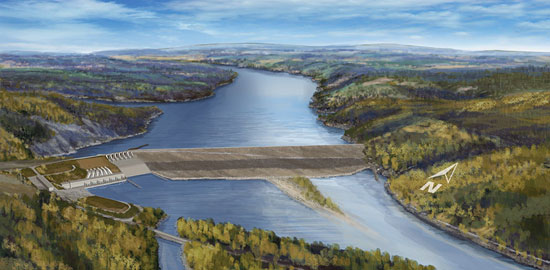the province leverages its carbon tax with carbon-offset funds, a formula that could prime the construction of hundreds of other privately held energy related projects.
A carbon-offset is a financial instrument representing a reduction in greenhouse gas emissions. Although there are six primary categories of greenhouse gases, carbon offsets are measured in metric tons of carbon dioxide-equivalent (CO2e). One carbon offset represents the reduction of one metric ton of carbon dioxide, or its equivalent in other greenhouse gases.
There are two primary markets for carbon offsets. In the larger compliance market, companies, governments or other entities buy carbon offsets in order to comply with caps on the total amount of carbon dioxide they are allowed to emit. In 2006, about $5.5 billion of carbon offsets were purchased in the compliance market world-wide, representing about 1.6 billion metric tons of CO2e reductions.
In the much smaller voluntary market, individuals, companies, or governments purchase carbon offsets to mitigate their own greenhouse gas emissions from transportation, electricity use, and other sources. For example, an individual might purchase carbon offsets to compensate for the greenhouse gas emissions caused by personal air travel. In 2006, about $91 million of carbon offsets were purchased in the voluntary market globally, representing about 24 million metric tons of CO2e reductions.
Offsets are typically generated from emissions-reducing projects. The most common project type is renewable energy, such as wind farms, biomass energy, or hydroelectric dams. Other common project types include energy efficiency projects, the destruction of industrial pollutants or agricultural byproducts, destruction of landfill methane, and forestry projects.
For the most part carbon-offsets are purchased from a company or an agency that holds a carbon-offset portfolio which consists of a variety of projects all seeking to lower CO2e emission. The more emission reductions they can prove, the stronger their portfolio is. These companies now trade on various exchanges, one being the Chicago Climate Exchange, another being the Montreal Climate Exchange.
In 2007, consumers and corporations in the US spent $330 million on offsets, but this amount might dwarf the potential as the US congress will be debating competing carbon-reduction plans this summer. The leading bill up for debate is the Lieberman-Warner Climate Security Act which would require companies to reduce their carbon emissions a full 70 percent by 2050 and will more than likely serve as the core legislation that Canada will use as a foundation to a similar carbon reduction law.
The Lieberman-Warner bill will allow companies to use carbon-offsets to achieve up to 30 percent of their reductions. Other proposals to congress allow a much higher percentage of carbon-offsetting.
When adopted into law the federally regulated offset market will grow to 40 times what it is today and could amount to over $13 billion in the US alone.
Carbon offsets represent a new form of investment that could be described as a corporate controlled tax that can at the end of the day realize huge profits for companies. In the old days a government would implement a tax that would force compliance, then with that money they would implement a plan to fix the problem – or not.
The future under offsetting has governments creating a guidance framework, and handing the problem off to corporations who then invest in their own version of problem solving – or not.
Here’s an example.
One of the most potent contributors to harmful emissions remains industrial pollutants such as hydrofluorocarbons known as HFC-23. Between 2003 and 2012, carbon-offset investment will pay $6 billion to refrigeration companies to incinerate 43,000 tons of HFC-23 which in turn will prevent the harmful emission from entering the atmosphere.
It’s important to note that while such carbon-offsets may be a good investment, the fact remains that the actual price tag for incinerating this HFC-23 is about $150 million. This means that the refrigeration companies are realizing a profit of well over $5 billion along with carbon-offset management firms.
And here lies the problem.
Carbon trading could be a proliferation of the free market into public spaces and environmental policy-making. Right now, a handful of companies managing carbon offset portfolios are scurrying around to find projects to sell to investors all with a very thin level of accounting and accountability.
Many carbon-offset projects that are being sold as good for the planet follow a dubious science with destructive impacts on local people and ecosystems. Critics of carbon trading, such as Carbon Trade Watch, argue that it places disproportionate emphasis on individual lifestyles and carbon footprints, distracting attention from the wider, systemic changes and the collective political action that needs to happen in order to really tackle climate change.
The criticisms are many, however carbon trading and offsetting is here to stay and it represents a new era in big picture problem-solving driven by the will of corporations. This new framework also represents the foundation of our next economic bubble. If the system could truly grow stewardship and social responsibility it could evolve the corporate agenda into a new sort of social enterprise.
Really, what about “poverty offsetting” or “cultural offsetting” or even “community offsetting” all requiring corporations to voluntarily spend a portion of their revenues on social targets as though they were part of business core operations.
Such scenarios will be in our future, whether corporate integrity will deliver the goods, that’s the real question.
But in the meantime you and I should be very careful about what we’re investing in as we consider buying into a carbon-offset portfolio. It’s no longer retirement savings at risk, it’s the planet.
(30)
Don Elzer writes and comments about the future, current affairs, lifestyle and the natural world. He is a director of the Watershed Intelligence Network publishers of The Monster Guide, which can be found at www.themonsterguide.com
He can also be reached by email at: treks@uniserve.com


